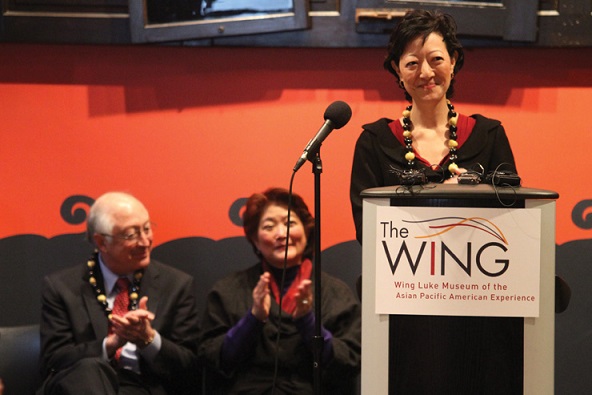Rhea Suh speaks at a Feb. 10 event at the Wing Luke Museum in Seattle. Seated in the background are Interior Secretary Ken Salazar and the museum’s executive director Beth Takekawa. PHOTO BY ALAN ALABASTRO
To Protect and Serve
Rhea Suh, assistant secretary in the Department of the Interior, has dedicated her life’s work to safeguarding this country’s natural resources.
by CHELSEA HAWKINS
When Rhea Suh walks into the Wing Luke Museum in Seattle, she is alone—there is no posse, no flocking press secretaries or looming security. Her age is hard to place; her hair is fashioned into a pixie cut, her dress is unassuming. But as the Assistant Secretary for Policy, Budget and Management in the Department of the Interior, she is one of the highest-ranking Asian Americans in the U.S. government.
Suh joined her boss, Interior Secretary Ken Salazar, last month as they announced the federal designation of the Wing Luke, a historic Asian American museum, as an affiliate of the National Park Service, basically insuring the museum’s preservation into perpetuity.
Suh has long been in the preservation business. The daughter of Korean immigrants, she was born and raised in Boulder, Colo., where early on she cultivated an interest in the environment and conservation issues. At her Senate confirmation hearing, the former earth sciences teacher talked about how she grew up reaping the benefits of the lands and waters managed by the federal government. She said her father taught her how to bait-fish for trout in Lake Granby, and as a Girl Scout, she camped out under the starry skies in Rocky Mountain National Park.
“My background taught me the importance of sustainable use of our resources, the protection of the most special place within our nation and the need to balance protection of those special places with the needs of local communities,” she said at the time.
That would translate into a career spent dedicated to protecting the environment. Prior to her appointment to the Department of the Interior, she managed a $200 million budget at the David and Lucille Packard Foundation, where she was charged with planning a six-year initiative to build ecological resilience in key lands and watersheds in western North America. She formerly consulted for the National Park Service, where she developed educational programs for low-income communities, bringing National Park lessons to public schools. The Columbia and Harvard graduate also served as a legislative assistant to Sen. Ben Nighthorse Campbell, for whom she worked on public land issues.
Articulate and youthful, Suh comes across as once serious and thoughtful, carefully mulling over her words as she answers questions, while maintaining a certain level of friendliness and candor. Just before the Lunar New Year festivities kicked off at the Wing Luke Museum, Suh took a moment to talk with KoreAm about her upbringing in Colorado and her path to the Obama administration.
How has your background as a Korean American influenced who you are today?
I have to say, growing up in Colorado in the ’70s, it was not the hotbed of diversity. There were very few people of color, period, and no other Koreans in the entire town for much of my childhood. Despite the fact that Boulder is a university community, the diversity of that community didn’t start changing until the ’80s, so it was a real challenge for us as a family, and it was a real challenge for me personally growing up. You know, things like having friends come to dinner and having them see kimchi and having no idea what it was or how smelly it is—the typical things that have been challenging for immigrants in the past.
But some of the more profound challenges associated with assimilation, I think, could be [attributed to] the fact my Korean is not very good. My parents made the conscious decision when [my siblings and I] were born to not actually teach us Korean because of the levels of discrimination they were facing. They wanted to do everything they could to insure that we had as good an opportunity we could get, and unfortunately, they thought that teaching us Korean would hinder that. I think you see a real difference in how immigrants today think about language and the retention of language. But I think in the early years in the immigrant experience … it was a real difficult challenge and decision for them that still has ramifications to this day.

Rhea with father Chung Ha Suh and sisters (right to left) Betty and Margaret, at the Grand Canyon National Park in 1974.
How did you come to work for an agency like the Department of the Interior?
My entire career actually has been focused on natural resource policy. I started out in college as an environmental science [and] education double major, so going into college, I already had a deep-seated interest in conservation issues. After I graduated, I got a job with a senator from my home state of Colorado, working on natural resource issues in Washington, D.C. After I left that position and after graduate school, I continued working on conservation issues in the nonprofit arena.
From that base of experience, I was put on the radar screen of the Obama administration as someone who could come in and help think about management issues and policy issues for the Department of the Interior. But it was certainly a surprise to get the phone call at the beginning of the first term of President Obama’s [tenure]. It really has been the honor of my life to work both for the President and [Interior] Secretary [Ken] Salazar.”
Can you tell us about the work you do now?
The job that I do at Interior is somewhat hard to describe, but the easiest way to put it is, essentially I am the functional COO of the department. I run all the financial and management matters for a department that has over $12 billion in annual discretionary budget and over 70,000 people across the country in our employee base. It’s a complicated department with eight different bureaus, with eight different missions, that really run the gamut, from standing up to our commitment and trust responsibilities to Native Americans, to powering the energy supplies—including conventional energy supplies to renewable energy supplies—for our nation, providing water to 11 western states and electricity to millions of customers through hydro-electric power, to running our national parks and all of our nation’s wildlife refuges.
What’s an average day in the life of Assistant Secretary look like?
[Laughs.] Well, I’m not sure how much of an average day I ever have, but it’s usually a combination of meetings and events and meetings.
What is one of the biggest challenges you face in your work today?
We’re headed into and experiencing already a very difficult fiscal time for the federal government. We’ve obviously been in a recession for quite some time as a country, but the ramifications of that recession … has yet to fully be decided. The battles you see in Congress right now about sequestration, fiscal cliff and budget really present the biggest challenges for thinking through how to manage an agency like ours. We are a very people-orientated agency. We manage lands and the people that take care of those lands. … The impacts of any budget discussions or budget shortfall will be dramatically pronounced in an agency like the Department of Interior.
Some of the concrete ramifications to significant budget cuts will be in our ability to sufficiently execute our mission. We have scores of refuges, national parks, national landscapes [where] we welcome the public day in and day out. Our ability to have those areas continue to be open to the public in the same way will be limited.
We as a country need to think through the priorities that we have for our federal government and think through the importance of the federal government’s delivery of both basic services and great amenities, like our national parks and refuges. There are real trade-offs and consequences to the discussions we’re having right now in D.C. We are, to the best of our ability, trying to manage that to have the least amount of impact on our employees and the American public, but we’re not sure if we’re going to actually get there.
In 2011 you traveled to South Korea for the 14th annual Future Leaders Conference, and you had a chance to meet with South Korean government and Seoul city officials about environmental issues. Can you tell me about what that trip was like?
When we think about Korea today, it is a world power, and it is an incredibly dynamic country that represents all sorts of opportunities to pursue, particularly in the incredible relationship that the United States has with South Korea. They are one of our greatest allies and greatest partners on all sorts of dimensions. When thinking through how to more broadly establish partnerships with South Korea on conservation issues, I think there’s a lot we can learn from one another.
Korea’s dealing with all sorts of challenges associated with the rapid urbanization of the peninsula and how they deal with environmental conservation in the face of that urbanization is fascinating.
You look at Cheonggyecheon, the river restoration that happened in Seoul under [former President Lee Myung-bak] when he was in the mayoral office—that is a huge opportunity for all urban areas all across the world to learn from. Trying to reclaim a lost river in the midst of a city of millions is just an extraordinary story, and if we can tell that story in the American context and we can replicate that story, it would be an incredible opportunity.
Rhea with mother Young Ja Suh, in Boulder, Colo., in 1978.
And on a personal level, what did it mean for you to visit?
The changes in Korea, just within my lifetime, are truly extraordinary. From the time when my parents left the country, when it was still very much war-torn and impoverished, to today where it’s the seventh largest economy in the world and … it represents the forefront of Asian culture and the promulgation of Asian culture worldwide; it’s just an amazing place. The energy, the excitement, the bustle—it is truly awe-inspiring.
For those of us who have been born in these two very distinct cultures and two very distinct country histories, we uniquely have the opportunity to be bridge builders, and there has never been a more exciting time for that bridge building than now between our two countries, and specifically in terms of the roles we can play as Korean Americans.
One thing that’s really exciting for young Korean Americans is the greater visibility of our community and culture. Is there anything you want to say to young Korean Americans?
It’s really critically important to involve more people that look like me in conservation issues because these are our nation’s assets as a whole. All of these lands that we manage at the Department of the Interior—and we manage a fifth of this nation’s landmass, that’s a lot of land—are owned not by just a portion of this nation’s population. They’re owned by all Americans.
The Korean American community has come a long way since the days when my parents landed on the shores of California. The opportunities for Korean Americans in all walks of life are unparalleled. … While, to be sure, there are still big challenges we face as a community and as individuals, we should be incredibly inspired and empowered by the real concrete gains we have made as a community and that, in and of itself, should give strength to young Korean Americans in whatever pathway they decide to choose.

Rhea with husband Michael and daugher Yeumi, at Yellowstone National Park in 2011.
I believe strongly in this country and the ability of this country to allow for everyone’s dreams to be realized, and I continue to believe the opportunities for Asian Americans, and Korean Americans particularly, are unlimited. In this administration, we have seen historic numbers of Asian Americans and Korean Americans appointed at senior levels, and it is just an additional piece of evidence of this President’s commitment to insuring that the federal government is not only fully representative of our population, but truly reflective of our population at the highest levels of government.
This article was published in the March 2013 issue of KoreAm. Subscribe today! To purchase a single issue copy of the March issue, click the “Buy Now” button below. (U.S. customers only. Expect delivery in 5-7 business days).








